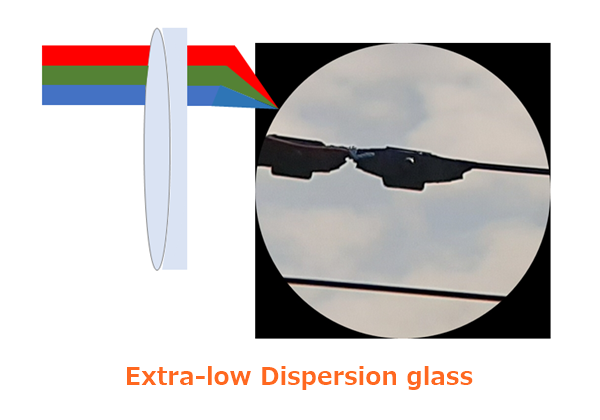Chromatic aberration has always been an issue affecting the image we see when using binoculars.
Although achromatic doublets have played a significant role in reducing chromatic aberration, there still remained a subtle colorful fringe at the edge of an object.
In some high-end telescopes, fluorite crystal is used for the objective lenses. Fluorite is not a glass but a kind of crystal, which is too fragile and expensive for mass production.
Instead of fluorite, ED (Extra-low Dispersion) lenses have become prevalent as they are much easier to manufacture than fluorite crystal. Although more affordable than fluorite crystal, ED binoculars are about 1.5 times the cost of conventional binoculars.
Today, ED lenses are mainly used in binoculars with an aperture larger than 40mm because chromatic
aberration becomes more noticeable with larger apertures and higher magnifications.
Comparison of an ED lens and a regular achromatic doublet
When using binoculars, you’ll usually notice a little purple fringe around objects. With a large pair and higher magnification, however, color fringing around objects such as branches against a white cloudy sky becomes much more apparent.
The chromatic aberration is caused by the fact that the focal point varies according to the wavelength of light. To minimize chromatic aberration, there have been great efforts to make these different wavelengths of light focus at the same point.
Although achromatic doublets can minimize color fringing by matching the focal points of red and blue,
lights with other wavelengths such as green still have different focal points.
We had not been able to remove chromatic aberration more until Extra-low Dispersion glass, which has a unique characteristic of dispersion, came along.
Compared with conventional optical glass, with an ED lens, the focal points of different wavelengths of
light are much closer, which greatly minimizes chromatic aberration.

The edges of electric wires have a purple hue.

As the various wavelengths of light come together much closer to one focal point, there is much less color fringing around the electric wires.
An ED lens does not necessarily mean “a sharp image.”
As mentioned above, an ED lens plays an essential role in minimizing color fringing. However, this does not necessarily mean the binoculars with ED lenses always produce a sharp image.
Besides the type of glass used to make the lenses, there are several factors that go into producing a
sharp image. For example, Nikon once produced 8×32 SE, a typical Porro Prism binocular design, which was excellent in every way, although it was made using conventional optical glass.
Therefore, if you see “ED glass” in the specifications, you might think, “Oh, this pair must have less color fringing.” But this is not always the case.

https://vortexoptics.com/vortex-viper-hd-10×42-binocular.html
In my opinion, if you want a pair with magnification higher than 8× and an aperture larger than 40mm, it is worthwhile to consider ED binoculars.

The terms ED, HD, UD, and XD have almost the same meaning: Extra-low dispersion glass.
Summary
Compared with conventional optical glass, ED glass greatly reduces the difference of focal points of different colors. Combined with other glasses, an ED lens can transmit an image with little apparent color fringing.
Although binoculars with ED lenses are common, the price is about 1.5 times compared to those with conventional lenses. So, I recommend you consider ED binoculars if you want a pair with an aperture larger than 40mm and a magnification higher than 8×.
Even though ED glass has been a breakthrough technology for binoculars, keep in mind that it can’t
solve all image distortion issues.
